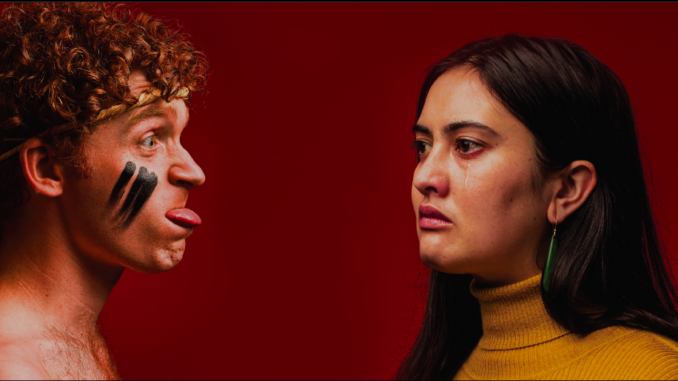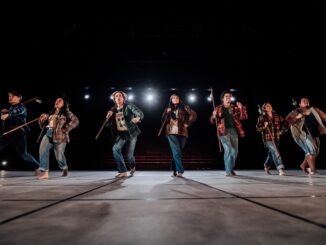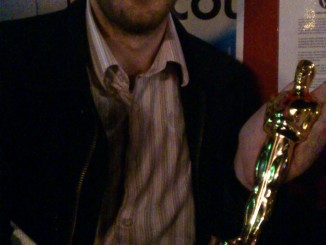
The Haka Party Incident explores a little-known act of resistance — when Māori activist group He Taua confronted University of Auckland engineering students about their annual tradition of performing a mock haka. For decades, Māori students and lecturers had complained about the racist caricature, which engineering students insisted was just drunken fun. But the country was in the midst of change, and after 1 May 1979 the mock haka was never performed again.
Written and directed by Katie Wolfe, the show enjoyed a sold-out season in 2021 and is currently on a six-centre national tour. I reviewed the show during its premiere, making this my second viewing. Coming along with me to Henderson’s Te Pou theatre was my good friend Morgan Dalton-Mill (Ngāti Whātua ki Kaipara), who was seeing it for the first time. We kōrero about the show and its impact.
Anuja: We’re both University of Auckland alumni, although we studied there about 40 years after the infamous haka party incident. Had you heard about it before attending the play?
Morgan: Āe — we covered it in one of my favourite university papers, Māori 130G, as part of a broader kōrero about Māori resistance against the Crown. In a way it was fitting that I learned about it on the grounds where the incident unfolded. I hadn’t heard about it before then, even though in my last year of History at high school we studied the colonisation of Aotearoa. Did you learn about it at high school?
A: No — I hadn’t heard about it before university (through a few throwaway references in a lecture). I don’t remember being told about He Taua, though, which makes hearing their voices in this show all the more important.
When I first saw the show, it was on the sprawling stage of the ASB Waterfront Theatre. You mentioned that the theatre at Te Pou has the dimensions of a wharenui. There was a general atmosphere of welcoming everyone into that space, allowing them to choose and settle into their seats before the play began about 10 minutes after the scheduled start time. How did the stage, and physical space more broadly, impact your experience of the show?
M: The Tokomanawa theatre has a high ceiling, with two ceiling panels that meet where the pou tokomanawa in a wharenui would be, and a huge amount of bare floor space. So stepping into the space immediately made me feel as though I was in a wharenui like those I’ve been to and stayed in. I thought this was appropriate because the wharenui is where important kaupapa is discussed, such as the kaupapa at the centre of this play.
I recently went to the Kiri Te Kanawa theatre at Aotea Centre to see an opera and I found the atmosphere extremely different. At the opera we started exactly on time, even though people were still making their way to their seats! There was more of a separation between the audience and the performers due to the traditional stage setup at the front, which is what you expect from the opera. How did you find the Tokomanawa theatre compared to the ASB?
A: I found the show powerful on John Verryt’s set at the ASB, but possibly more so on his set here. Katie Wolfe described Te Pou as “a dynamic space very like the Matatini stage” in which the play is “ideally suited to shine”, and I agree.
One of the members of He Taua, Miriama Rauhihi-Ness (played by Roimata Fox), says the intention of He Taua in going to confront the engineering students was to “occupy a space”. Being smaller than the stage at ASB, I had a more vivid sense of who was dominating the space and who was being pushed out. We saw the engineering students rampaging through it, driving home their sense of entitlement: to the university, to the city, to Māori culture. We saw the show forcing them and He Taua to share that space, as they’re lined up side by side to recount their memories of the incident. And we saw the editor of the university magazine interview Ben Dalton (Kauri Williams) slightly off to the side, as if to reflect Ben’s marginalised perspective — before Ben took centre stage to address the racism perpetuated by our institutions. Those institutions had been lurking there invisibly all along and Ben was calling them out.
M: I agree with Katie too. The stage was a space with a grid on top of it rather than a traditional stage, so the actors weren’t limited to performing within the boundaries of a set or hidden behind curtains. I attended Te Matatini this year and that stage offers so much potential. There’s no height restriction and there’s so much room, allowing kapa to create patterns and shapes in their haka brackets using diverse movements and levels. This play embraced that potential.
A scene I thought reflected a powerful use of space was when the He Taua members were interrogated by the Police. They stood spaced out at the back of the room facing the audience, while the two Police stood at the front but with their backs to us. As the members recounted their stories of Police brutality, they stepped forward into the light. When the Police responded to each member, they stepped towards the back of the room.
I liked how the space could be anywhere: the Police station, the engineering school, AUSA house, someone’s kāinga or a more liminal space. As the actors portrayed more than one person, you could also easily follow their transitions between “characters” as all they had to do was change their accent/tone of voice/pace/posture, instead of the whole set.
A: I agree; the Police scene was painful to watch. The way we could only hear the voices of the Police while they showed us their backs really made me think of the facelessness of racism. It’s not just an interpersonal issue; it’s embedded in our societal structures.
Your comment about the numerous characters brings me to the verbatim style of the show. Its script was compiled from interviews Katie Wolfe conducted with various people impacted by the incident, and their words are directly voiced onstage. What did you think of this technique? Did it make the events feel more authentic to you?
M: Absolutely. I didn’t know this was verbatim theatre when I was watching it but I noticed that some of the characters had things like stutters and different accents which made the actors’ performances more realistic. Now that I know about the technique, I think it’s a powerful and important tool for this play. Hearing these people’s real words supports what I consider one of the important kaupapa of the show, which is to increase awareness and education about this event. Experiencing the story live added a dimension that a TV documentary wouldn’t have — I felt like the person was right there explaining the situation to me.
Allowing those actually involved in He Taua and the haka party to share their views on (and in) their own terms respected the mana of each person represented in the play. In my view, that’s more impactful than paraphrasing people’s words, which can undermine their lived experiences due to the potential for misunderstanding their perspectives. What did you think?
A: I completely agree that using their original words respected the mana of those involved. I also agree with the documentary comparison. I don’t think you could splice together contrasting perspectives as effectively onscreen. You could cut from the words of He Taua to those of an engineering student, but you couldn’t make them share the same physical space.
I’d never watched a piece of verbatim theatre and I thought every actor carried it off impressively. There was a scene in which Lauren Gibson switched rapidly between about three different people and you could tell instantly who was speaking. The device lent the show a sense of immediacy and, predictably, a very human element to the dialogue. It preserved every um and ah, as well as the humour that can creep into people’s accounts of even quite serious events. I’m thinking of Miriama and Hilda Halkyard-Harawira (Nī Dekkers-Reihana) giggling about riding a motorcycle to scope out the engineering students’ location. Were there any moments, funny or serious, that stuck out to you?
M: As we discussed, the Police scene hit me hard. I had two realisations during it: I hadn’t heard about this aspect of the incident before; and it was horrifying how recently this violent and unwarranted interrogation had occurred. Nī Dekkers-Reihana’s performance particularly affected me. Nī was stoic while retelling Hilda’s story, but was crying too (to which I responded by crying myself!)
Miriama’s words at the beginning also hit home: “Being Māori is something no one can take away from you.” Despite the continuing trauma of colonisation — all the loss of land, of culture, and (not completely) of te reo Māori — Māori are still here and still resisting. For those who whakapapa Māori, you are Māori. I’ve been on a haerenga with my taha Māori ever since I was in primary school and I know firsthand what it’s like to feel whakamā about being Māori. Through awhina and tautoko from whānau, friends, lecturers and others, I have embraced my whakapapa and I will stand steadfast in the knowledge that I am Māori, no matter what anyone else thinks.
A: We can’t talk about the show without talking about the kapa haka! The kaiako kapa haka/kaitito haka was Nīkau Balme, who composed one of the haka performed. There was some great comedy flowing from the engineering students’ butchering of the haka, but the one on my mind is definitely the final haka composed by Nīkau, He Taua. It was powerful, too, to see some audience members perform a haka in response.
M: That haka was a standout. Seeing it filled me with awe and pride. I’m no expert in kapa haka or te ao Māori broadly, but I thought He Taua was a wonderful example of a haka with kaha, ihi and wehi. It was at full volume and the singing was out of this world. I enjoyed watching the taiaha used correctly during this haka compared to the other parody haka by the engineering students. I was also thrilled to see Nī lead parts of this haka. It was a moving way to finish a moving play — I was in tears for so many reasons afterwards.
The Haka Party Incident plays Te Pou Theatre 1-11th June 2023




Leave a Reply